In March and early April we can still take advantage of the availability of
the Great Orion Nebula as an example of a region of star birth. Past mid April,
though, I just skip this and go on to the Big Dipper.
- If Orion has not yet been lost to the horizon, our telescopes are set up
and then are immediately trained directly on the Great Orion Nebula. So,
now... as we all stare off into the West... who sees something they
recognize? (Someone usually recognizes Orion.) This is the brightest
constellation in the sky. Orion is a great hunter and mortal enemy of
Scorpius, the Scorpion, which is why they are placed on opposite sides of
the sky -- as we watch the last of Orion disappearing over the Western
horizon we can turn and watch the head of Scorpius peaking above the eastern
skyline to check that the coast is clear. When one rises the other sets,
they are never seen together. {Trace out Orion, noting the belt, one
raised arm holding a club, the other outstretched holding a pelt.}

- The two brightest stars have their own names. The one at Orion's
shoulder, to your left, is Betelgeuse, pronounced "beetle juice", yes,
like the movie, and the one at Orion's knee, near the horizon, is Rigel.
Do you notice anything special about Betelgeuse? See how red this star is?
It is actually a red super-giant star. This star is enormous. Placed
where our sun is, the surface of Betelgeuse would reach to somewhere between
the orbits of Mars and Jupiter. It is so big that we have been able
to make an image of it and measure its diameter even though it is about
500 light years away.
There is only one other red super-giant that is this bright and it's
on the opposite side of the sky -- the Heart of the Scorpion -- the star
Antares. Both stars are about 500 ly away in opposite directions so we
lie about halfway between the two. Such stars are rare -- there are only
200 known red super-giants and all are much dimmer, and therefore much
farther away than these two stars.
- Notice that there's a sword that hangs from Orion's belt. See how the
the sword gleams? That is not a trick of your eyes, there's something
there, more than just a few stars. You can see it through binoculars,
and you can see it better through the telescope.
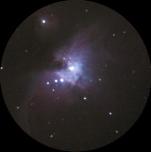
The Orion Nebula (M42) in a small telescope |
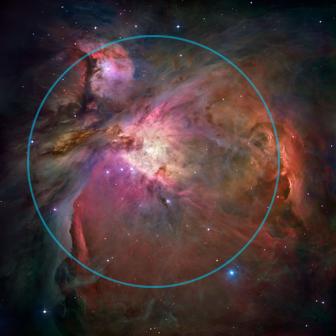
What you're actually looking at |
This is the Great Orion Nebula, considered by
astronomers to be a "diffuse nebula"- a cloud of dust and hydrogen gas -
the stars you see there were formed from the gas when it condensed together
and compressed due to gravity then, under pressure, heated up and ignited.
A nebula like this, then, is the birthplace of stars.
This region of the sky, Orion and its neighboring constellations,
happens to be one that is dense with nebulae and young stars. The only
other region of the sky with this much new-star formation activity is
Scorpius & Sagittarius -- the opposite side of the sky.
This nebula is remarkably clear in a telescope, binoculars, or even
to the fiercely concentrated eyeball. The longer you look, the more
detail you can see. Notice in the telescope how the nebula forms the
shape of a ghostly bat. Look very carefully at the bright star at the
center of the nebula. It's not just one star, it is actually FOUR! In
fact these four stars have a special name, they are called "The Trapezium".
It is their energy that lights up the nebula.
The Great Orion Nebula is huge beyond comprehension -- what you are
seeing is about 1500 light years away from us. The bright region you can
see is about 5 or 6 light years across, however long-exposure photographs
show that this nebula covers nearly the entire constellation of Orion!
- You can extend the line of Orion's belt to the right toward a "V" of
stars nearby. This is the face of Taurus the Bull. {Trace out Taurus,
showing the face, the horns, and the two forelegs.} Some people try to
fit the whole bull into the stars that are the legs and it comes out
looking like something from a Picasso painting. That very bright star
on the top left corner of the "V" is Aldebaran, pronounced "all-DEB-uh-ron".

- See that little cluster of stars right about where the
shoulder of the bull would be? That is the Pleiades, or the Seven Sisters.
Can you count seven stars just by looking? Some people see six, some see
seven. Actually you can find more than seven stars in binoculars and even
more in the telescope. The better you can see this exquisite star cluster,
the more beautiful it gets.
This is a true "galactic cluster", meaning a group of stars all born
out of the same cloud of gas. Sometimes these are called "open clusters".
In photographs of the Pleiades you can still see traces of gas around the
stars, remnants of the original nebula. The Pleiades lie 400 light years
away from us, with a total of 500 stars in the cluster. Nine are so bright
they have their own names.
- You want to see a star cluster that's three times closer than the
Pleiades? The "Hyades" cluster is only 130 light years away from us. So
where is the Hyades? It is the ENTIRE FACE OF THE BULL, with the notable
exception of Aldebaran. Part of the reason that Aldebaran is so much
brighter than the rest of the "V" is that it is only half as far away,
at 65 light years.
Usually a star cluster looks like a tiny fuzz ball, but the Hyades
appears to be a huge and distinct group of stars spread out over the sky
because it's so close. Like the Pleiades, the group consists of about
400-500 stars total. Also like the Pleiades, this is a true galactic
cluster, born from the same cloud of gas and all moving together in the
same direction in space. They are moving away from us, toward Betelgeuse,
and in 50 million years they'll be just another little fuzz ball near that
star. So enjoy it now while you can. The Hyades is estimated to be about
400 million years old, making it a fairly old star group for an open
cluster.
By comparison the Pleiades are much younger, at "only" 100 million years
old. Galactic clusters usually are relatively young, since events conspire
to break these groups up over time. The sun has long since left the nebula
and cluster of its birth, travelling now through the galaxy alone, with
only us to keep it company.
- It's hard not to notice that really bright star to the South of Orion.
That's not a planet, although it could pass for one. It's Sirius, the
brightest star anywhere in the sky. It's called the Dog Star because it is
actually the nose of the Big Dog, Canis Major. {Trace out Canis Major,
showing two eyes, the nose, front legs, back legs & tail}.
Some people see Sirius as the dog's collar, I prefer seeing
the eyes & nose myself.
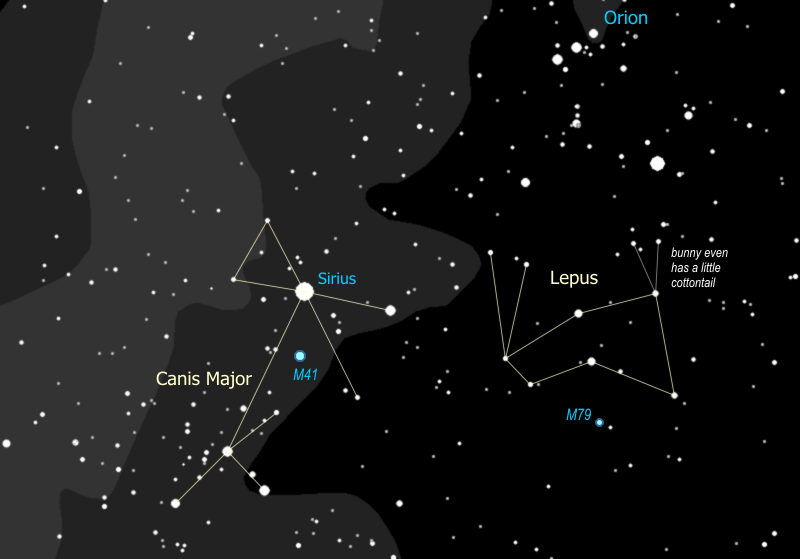
- Of the stars you can see by eye, Sirius is the second closest, only about
9 light years away. Anyone know the closest? Yes, Alpha Centauri, which
is 4 light years away, and can only be seen in the Southern hemisphere.
Sirius is actually a double star. It has a white dwarf companion, a star
that has blown off its outer envelope of gases and collapsed into a burning
core that is about the mass of the sun packed into space about twice the
diameter of the earth. A white dwarf is what our sun will eventually
become. The companion can only be seen in the biggest telescopes, we
can't see it with our little bitty one.
Lepus, of course, is lost to the horizon by now.
- Above the Pleiades and to the North (off to the right) you see another
grouping of bright stars. This is the constellation Perseus, representing
the ancient Greek hero of the movie "Clash of the Titans". The triangle
that forms his head, though of modest brightness, is an easy feature to
recognize, then the rest of the figure, which is pretty bright, is easy to
follow from there. {Trace out Perseus}. His right arm is holding his
shield, and in his left hand he has the head of Medusa the Gorgon. Being
a man of action, he comes directly from his triumphant victory over Medusa.
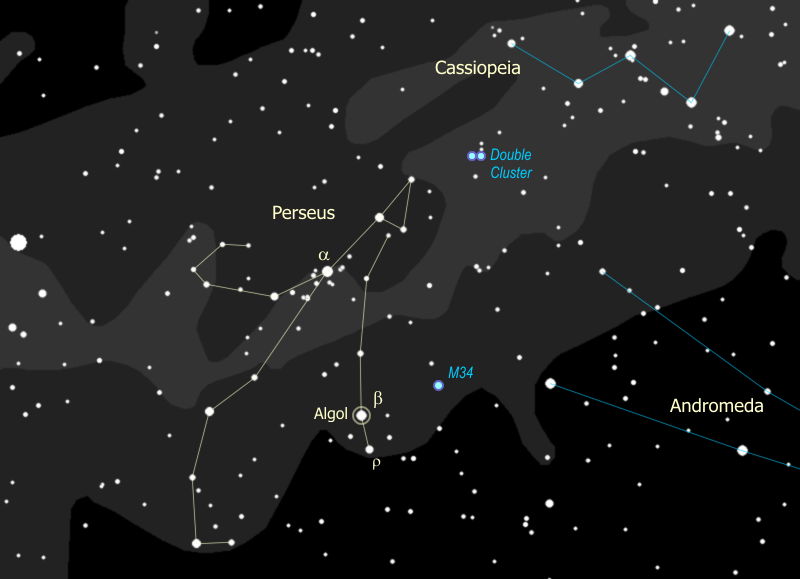
- The eye of Medusa is well-represented by the star Algol {point out Algol}.
Since ancient times Algol has been called the "Demon Star", and in fact the
name means "head of the demon". Why? Because this star winks at you.
Since stars aren't supposed to do that, it kind of gave people the willies
long ago, and they figured it had to be evil or posessed or in some other
way just wrong. Normally Algol is nearly as bright as
a Persei {point out a},
almost exactly as bright as g Andromedae. Sure
enough, just about every 3 days Algol drops in brightness to that of
r Persei {point out r}.
It stays like that for a few hours then goes back to being as bright as
a. Any guesses why something like this might
happen?
Algol is actually a binary star, and the orbit of the two stars is right
in line with us, so each time one star passes in front of the other, the
second one is blocked and we see only half the light. This is called an
"eclipsing binary". This is not the same as a Cepheid variable, where the
star itself is changing. So what do you think -- is Algol in eclipse right
now? We will check on it again when we get the chance and see if we can
spot the change.
- If it seems to you that there are an awful lot of stars around
a Persei that's because there are... that is a
true glactic cluster of stars, like the Pleiades, all formed together. This
group is just a little bit farther than the Pleiades and a little more
scattered. They look spectacular in binoculars, with many very young, hot,
blue stars (the cluster is about 50 million years old, about half the age
of the also very young Pleiades).
- You can spot another cluster in Perseus half way between Algol and
g Andromedae -- an easy target for binoculars
and with a really dark sky, one you should be able to spot just by looking.
This is M34, about 1500 light years away and very similar in nature to the
Pleiades or the a Persei moving group,
about 100 million years old and just about 3 times as far away.
- But the best cluster in Perseus is really two clusters, the Double
Cluster halfway between Perseus and Cassiopeia. You can find it easily
in the binoculars, and this is definitely worth getting in the telescope.
The one closer to Cassiopeia called "h Persei" and is "only" about 6 million
years old. The one closer to Perseus is called "c
(chi) Persei" and is 12 million years old. How can you tell that
c Persei is older? If you look at it carefully
in the telescope you might be able to spot 3 red giants in
c Persei, whereas h Persei has no stars old
enough to have evolved yet into red giants.
|
Double Cluster with c Persei to the left
and h Persei to the right
|
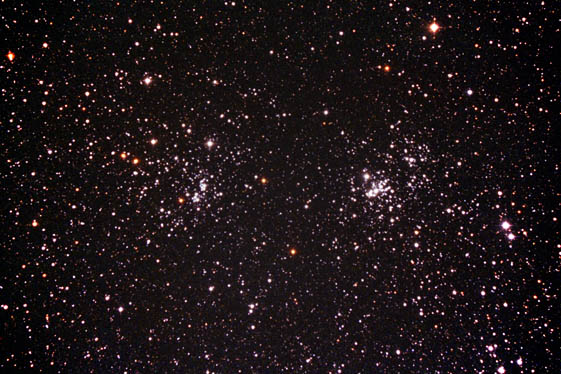 |
- We've seen a very close star cluster, the Hyades, which at 130 light years
is the second closest to us. So, then, what would be the closest
star cluster? Let's take a look way to the North...











 Back to Spring Home Page
Back to Spring Home Page
 Go to Index
Go to Index
 On to the Polar Constellations
On to the Polar Constellations